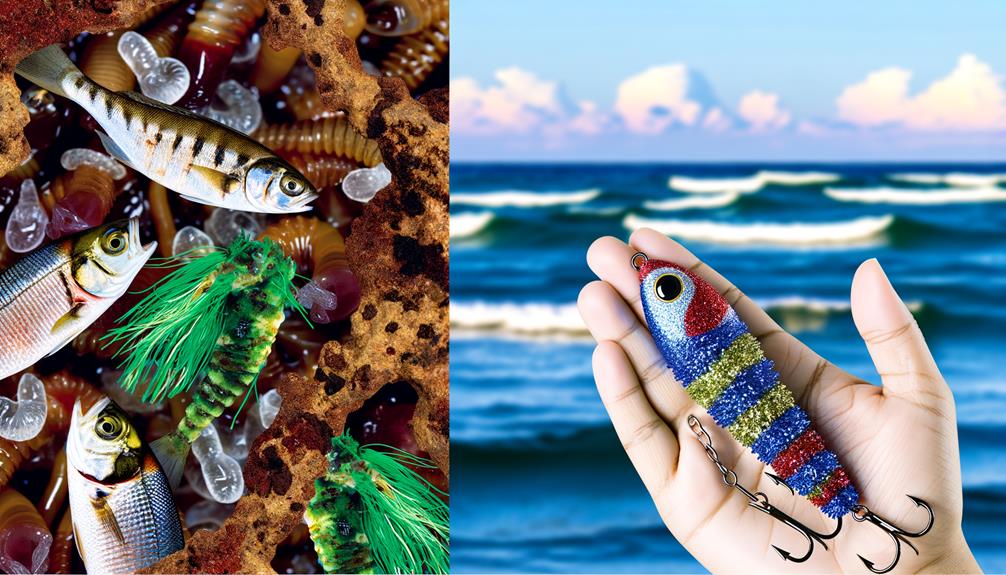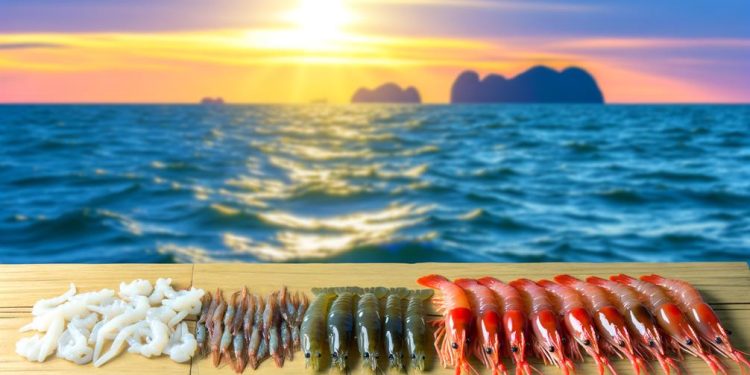In the realm of saltwater fishing, selecting an optimal bait is a multifaceted decision influenced by the target fish species, local ecosystem, and the angler’s strategy. The efficacy of live bait such as shrimp, pilchards, or crabs is often touted, yet the convenience and versatility of artificial lures cannot be discounted.
The choice of bait size, mirroring the fish’s natural diet, and the accessibility of bait are also significant considerations. The complexity of this topic warrants further exploration and discussion, particularly for those seeking to enhance their saltwater fishing success.
Key Takeaways
- Live baits like shrimp, mullet, and pilchards effectively attract a wide range of saltwater fish due to their natural movement and scent.
- Artificial lures such as Paddletail Soft Plastic and Gold Spoons provide versatility and are reusable, making them a convenient option.
- Matching the bait size and type to the target fish species increases the chances of a successful catch.
- The choice between live bait and artificial lures relies on the angler’s preferences, targeted species, and the specific fishing scenario.
Understanding Saltwater Bait Basics
Delving into the essentials of saltwater bait, one must first acknowledge that live bait proves to be more abundant and effective than artificial lures, primarily due to the natural diet of ocean-dwelling fish. Live bait such as shrimp, squid, or small fish, presents a tantalizing meal to predatory species, closely mimicking their usual prey.
It’s crucial to understand the versatility and variety of live bait types available for saltwater fishing. From the universally attractive live shrimp to the often overlooked squid, each live bait type offers unique advantages. Moreover, hundreds of bait options exist in saltwater, presenting both an opportunity and a challenge for anglers.
Crucially, matching bait size to the size of the target fish can significantly increase your fishing success. Smaller bait may not attract larger fish, while oversized bait could intimidate smaller species. Therefore, understanding the size preferences of your target species is pivotal.
Furthermore, the natural diet of the fish greatly influences bait choice. Offering bait that aligns with the fish’s typical food sources not only increases your chances of a catch but also promotes a more sustainable fishing practice.
Lastly, live shrimp are a versatile bait option, appealing to a broad range of ocean fish species, making them a staple in any saltwater angler’s arsenal.
Selecting Bait Based on Target Species
Building upon the basics of saltwater bait, it becomes imperative to tailor your selection to the target species, taking into account their natural diet and size preferences for a more successful fishing experience. Matching the bait to your target species not only increases your chances of a good catch but also enhances the sense of accomplishment and belonging that comes with mastering the art of saltwater fishing.
Consider, for instance, predator fish. These species, which include everything from the majestic marlin to the sleek barracuda, often prefer to chase live bait fish. These saltwater fishing lures imitate the natural diet of these predators, as they’re constantly on the hunt for smaller fish to consume.
On the other hand, species like sea trout or red drum are more attracted to crustaceans, making live shrimp an excellent choice. These baits are universally appealing and can significantly improve your saltwater fishing results.
Top Live Baits for Saltwater Fishing

In the realm of saltwater fishing, several live baits consistently prove to be effective in attracting a variety of species, owing to their natural movement, scent, and resemblance to the prey in their natural diet. The inherent vitality of these live baits makes them irresistible to most fish, enhancing your chances of a successful catch.
- Live Shrimp: These are universally attractive to many ocean fish. The natural movement and scent of live shrimp make them an irresistible choice for most saltwater species.
- Pilchards (White Bait/Greenies): Preferred by inshore game fish, pilchards are known for their effectiveness in saltwater fishing. Their size and color mimic the natural prey of many fish, making them an excellent bait.
- Mullet: Found in shallow areas, mullet are versatile live bait. They are particularly effective when used alive or as cut bait, enticing a wide range of species.
Additional worthy mentions include: Pinfish, suitable for both inshore and offshore fishing, and Threadfin Herring, known for being productive in offshore fishing. Both offer easy capture and broad appeal to various saltwater species.
Armed with this knowledge, you are now better prepared to engage in the rewarding practice of saltwater fishing.
Essential Saltwater Fishing Lures
While live bait is undoubtedly effective in saltwater fishing, an array of lures has also proven indispensable for their unique ability to attract diverse saltwater species. Paddletail Soft Plastic, a highly versatile saltwater lure, is effective in drawing strikes from predator fish at various depths. This artificial lure is a favorite among anglers for its adaptability.
Gold Spoons, another critical component in the world of saltwater lures, are a common sight in inshore fishing. Their various shapes and colors are irresistible to a wide range of saltwater species. Power Prawns, artificial shrimp lures, are attractive to most saltwater game fish, enhancing the likelihood of a successful catch in various fishing scenarios.
In the realm of artificial lures, the classic White Bucktail jigs hold a special place. Renowned for catching multiple species like snook, redfish, and speckled trout, they are a must-have for any saltwater angler. Lastly, topwater lures such as the Salt Strong Moonwalker and Heddon Zara Spook provide thrilling action on the water surface, effectively attracting saltwater fish and heightening the overall fishing experience.
Comparing Live Bait and Artificial Lures

The debate between the use of live bait and artificial lures in saltwater fishing presents a compelling dichotomy, each offering distinct advantages and drawbacks that can significantly impact an angler’s success. Live bait, with its inherent natural movement and scent, has proven to be highly effective in attracting a broad range of saltwater fish species. Its authenticity can lure in even the most reticent fish, but it can also be messy and challenging to handle.
On the other hand, artificial lures offer exceptional versatility, allowing anglers to adapt to varying fishing scenarios. They are reusable, durable in saltwater environments, and can mimic natural prey, albeit without the scent or exact movement of live bait. Notably, these lures provide convenience and can be selected based on targeted fish species and water conditions.
When comparing these two approaches:
- Live bait offers natural movement and scent, attracting a wider range of fish.
- Artificial lures provide versatility and reusability, ideal for specific scenarios.
- Convenience and reduced mess are benefits of artificial lures, but they lack the authentic scent of live bait.
In essence, the choice between live bait and artificial lures depends on the angler’s preference, their fishing goals, and the specific circumstances they face.
Frequently Asked Questions
What Bait Attracts the Most Fish?
The most attractive bait depends on factors like bait preferences, species specificity, and seasonal variations. Both live and artificial baits can be effective, but bait preservation also plays a crucial role in attracting the most fish.
What Is the Easiest Way to Catch Saltwater Fish?
Understanding fish behavior, tide influence, and ideal fishing times is crucial. Using appropriate saltwater gear and optimal boat positioning can significantly enhance your fishing experience, making it easier to catch saltwater fish.
How Do You Lure Fish in Saltwater?
Saltwater fly fishing requires understanding fish behavior, appropriate tackle selection, and efficient fishing techniques. Seasonal variations also play a role, with different species being more active and receptive to lures at different times of the year.
What’s Good for Saltwater Fishing?
Effective saltwater fishing requires apt tackle selection and casting techniques, understanding of tide influence, and accurate fish species identification. Distinguishing between offshore and inshore fishing practices also significantly enhances one’s chances of a successful catch.
Conclusion
In conclusion, successful saltwater fishing hinges significantly on the careful selection of bait, whether live or artificial. By understanding the dietary preferences of the target species and selecting baits that mimic their natural prey, anglers can significantly increase their chances of a successful catch.
Therefore, a knowledgeable approach to bait selection, informed by local resources and the natural ecology of the fishing area, remains paramount in achieving a rewarding saltwater fishing experience.




